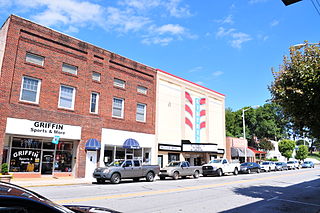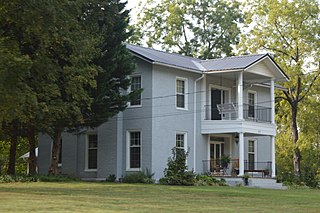
Mocksville is a town in Davie County, North Carolina, United States. The population was 5,051 at the 2010 census. It is the county seat of Davie County.

The Downtown Main Street Historic District is a national historic district located at North Wilkesboro, Wilkes County, North Carolina. It encompasses 29 contributing buildings in the central business district of North Wilkesboro. It developed between about 1891 and 1952, and includes notable examples of Classical Revival and Early Commercial style architecture. The architectural firm Benton & Benton designed the former Bank of North Wilkesboro II (1923), the Hotel Wilkes (1926), and the former Town Hall (1939). Other notable buildings include the Liberty Theater, former Bank of North Wilkesboro (1892), and Tomlinson Department Store (1927).

Halifax Historic District is a national historic district located at Halifax, Halifax County, North Carolina, US that was listed on the National Register of Historic Places in 1970. It includes several buildings that are individually listed on the National Register. Halifax was the site of the signing of the Halifax Resolves on April 12, 1776, a set of resolutions of the North Carolina Provincial Congress which led to the United States Declaration of Independence gaining the support of North Carolina's delegates to the Second Continental Congress in that year.

Downtown Burlington Historic District is a national historic district located at Burlington, Alamance County, North Carolina, United States. It encompasses 40 contributing buildings in the central business district of Burlington, and was added to the National Register of Historic Places in 1990.
Downtown Asheville Historic District is a national historic district located at Asheville, Buncombe County, North Carolina. The district encompasses about 279 contributing buildings and one contributing object in the central business district of Asheville. It includes commercial, institutional, and residential buildings in a variety of popular architectural styles including Colonial Revival, Queen Anne, and Art Deco.

Lenoir Downtown Historic District is a national historic district located at Lenoir, Caldwell County, North Carolina. The district includes 41 contributing buildings and 2 contributing objects in the central business district of Lenoir. It includes commercial, governmental, and institutional buildings in a variety of popular architectural styles including Art Deco, Art Moderne, Classical Revival and Tudor Revival. Notable contributing resources include the Center Theater (1941), O. P. Lutz Furniture Company and Lutz Hosiery Mill (1939), Dayvault's Drug Store (1937), Caldwell County Agricultural Building (1937), Courtney Warehouse, Masonic Hall, Miller Building, Confederate Monument (1910), Belk's Department Store (1928), Lenoir Building (1907), J. C. Penney Department Store, Fidelity Building (1928), and U. S. Post Office (1931). Located in the district is the separately listed Caldwell County Courthouse.

Newton Downtown Historic District is a national historic district located at Newton, Catawba County, North Carolina. The district encompasses 50 contributing buildings and 5 contributing objects in the central business district of Newton. Notable buildings include the First National Bank of Catawba County, H&W Drug Company, Belk-Brumley Department Store, Alman Furniture Company Building, Catawba County Courthouse (1924), Ervin Apartments (1936), Sanitary Grocery, Freeze Drug Store, Catawba County Library (1954), Haupt Building, City Hall and Fire Station, and Eagle Building.

Thomasville Downtown Historic District is a national historic district located at Thomasville, Davidson County, North Carolina. The district encompasses 46 contributing buildings, 1 contributing site, 2 contributing structures, and 2 contributing objects in the central business district of Thomasville. It includes commercial and governmental buildings built between 1871 and 1938. Located in the district is the separately listed Thomasville Railroad Passenger Depot. Other notable contributing resources include The Big Chair (1950), the former City Hall (1938), the former Davidson County Office Building, the former United States Post Office (1926), (former) Davidson County Office Building (1957), the Dr. Orien R. Hodgin Dental Office, the North State Telephone Warehouse, First National Bank of Thomasville (1922), C. R. Thomas Block, and the Lambeth Furniture Company/Thomasville Chair Company.

Davie County Courthouse is a historic courthouse located at Mocksville, Davie County, North Carolina. It was built in 1909, and is a two-story reinforced concrete and tan brick structure in the Classical Revival style. It features a tetrastyle Corinthian order in antis portico which shelters the center front entrance, with an ornate square clock cupola. The building was restored and renovated following a fire in 1916. The interior was renovated in 1971.
Cana Store and Post Office is a historic general store and post office building located near Mocksville, Davie County, North Carolina. It was built about 1875, and is a two-story, three-bay, frame building with a gable roof. The front facade features a broad hip-roofed frame canopy added in the 1930s that serves as a porte-cochere. Also on the property is a contributing one-story woodshed built in the 1930s. The building housed a post office until 1954 and a general store until 1965.

North Main Street Historic District is a national historic district located at Mocksville, Davie County, North Carolina. The district encompasses 115 contributing buildings and 2 contributing sites in a linear residential section of Mocksville. It was developed between the 1840s and World War II and includes notable examples of Greek Revival, Italianate, Gothic Revival, Queen Anne, Classical Revival, Shingle Style, American Craftsman, Tudor Revival, and Colonial Revival style residential architecture. Also in the district are the First Methodist Church (1896), the Mocksville Graded School (1911), and the Masonic Picnic Grounds, established in 1883.

Salisbury Street Historic District is a national historic district located at Mocksville, Davie County, North Carolina. The district encompasses 40 contributing buildings in a predominantly residential section of Mocksville. It was developed between the 1820s and World War II and includes notable examples of Greek Revival, Italianate, Queen Anne, and American Craftsman style residential architecture. The dwellings are predominantly one- and two-story log and frame houses. Also in the district is the (former) Mocksville Academy.
Boxwood Lodge is a historic hunting retreat and national historic district located near Mocksville, Davie County, North Carolina. The district encompasses 8 contributing buildings, 1 contributing site, and 4 contributing structures on a rural estate including a manor house. It was developed between 1911 and 1931 by William Rabb Craig (1870-1931), a wealthy cotton and sugar broker. The manor house was built between 1933 and 1934, and is a two-story, "H"-plan, brick Colonial Revival dwelling designed by the architectural firm Delano & Aldrich. Other notable resources include the grounds of Boxwood Lodge, greenhouse, log cabin, great barn (1910s), feed / grain house, and entrance piers (1934).

Farmington Historic District is a national historic district located at Farmington, Davie County, North Carolina. The district encompasses 87 contributing buildings, 2 contributing sites, and 3 contributing objects in the unincorporated community of Farmington. It primarily includes residential, agricultural, commercial, religious, and educational buildings with notable examples of Greek Revival, Italianate, Queen Anne, American Craftsman, and Colonial Revival style architecture. Notable contributing resources include the Farmington Community Cemetery (1881), Wiseman-Kennen House (1873), Dr. Lester P. and Helen Bahnson Martin House, Williard Garage (1920s), Francis Marion Johnson Store, Charles F. and Jane A. Bahnson House, Jarvis-Horne Store, Brock Marker, Farmington School Auditorium, Cafeteria, and Home Economics Classroom, Farmington School Agricultural Building (1936), (former) Farmington Baptist Church (1882), Farmington Methodist Church, and Farmington Post Office/Barber Shop.

Downtown Gastonia Historic District is a national historic district located at Gastonia, Gaston County, North Carolina. It encompasses 77 contributing buildings and 1 contributing object in the central business district of Gastonia. The commercial, civic, institutional, and multi-unit residential buildings were built between the 1890s and 1954, and include notable examples of Colonial Revival and Classical Revival architecture. Located in the district are the separately listed former Gaston County Courthouse, First National Bank Building, Third National Bank Building, and Robinson-Gardner Building. Other notable buildings include the U.S. Post Office (1935), York Medical Building (1938), Kress Department Store, Leibowitz Department Store, Ideal Moving Picture Theater, City Hall, Kirby Building (1922), First Baptist Church (1922), Gaston County War Memorial Hall (1928), and the (former) Gaston County Public Library (1930).

The Bessemer City Downtown Historic District is a national historic district in Bessemer City, Gaston County, North Carolina. It encompasses 23 contributing buildings and 10 contributing structures in Bessemer City's central business district. The buildings were built between after 1896, and include one- and two-story commercial buildings and two large, sprawling textile mill complexes. Notable buildings include:

Downtown Greensboro Historic District is a national historic district located at Greensboro, Guilford County, North Carolina. The district encompasses 96 contributing buildings in the central business district of Greensboro. The commercial buildings were built between about 1885 and the 1930s in a variety of popular architectural styles including Italianate and Art Deco. Located in the district is the separately listed Jefferson Standard Building. Other notable buildings include the Vanstory Building, Kress Building (1929), Woolworth's, Efrid's Department Store, Montgomery Ward (1936), the Carolina Theatre (1927), Center Theatre (1948), the former Belk Building (1939), Ellis Stone/Thalhimer's Department (1949-1950), and the former American Exchange National Bank Building (1920). The Woolworth's store is notable as the site of the Greensboro sit-ins of 1960.

Downtown Sanford Historic District is a national historic district located at Sanford, Lee County, North Carolina. It encompasses 53 contributing buildings in the central business district of Sanford. The district includes notable examples of Colonial Revival, Tudor Revival and Art Deco style architecture, with buildings largely dated between about 1895 to 1930. Located in the district are the separately listed Railroad House and Temple Theatre. Other notable buildings include the Sanford Buggy Company, McCracken Building, Passenger Depot, City Hall, Coca-Cola Bottling Company, Masonic Lodge, Makepeace Building (1924), Wilrick Hotel (1925), Bowers Building, Cole Pontiac Building, Hubbards Shoe Store (1926), Carolina Hotel (1930), and former U. S. Post Office.

The Waxhaw Historic District is a national historic district located at Waxhaw, Union County, North Carolina. It encompasses 93 contributing buildings, 3 contributing structures, and 1 contributing object in the central business district and surrounding residential sections of Waxhaw. The district developed between about 1888 and 1940 and includes notable examples of Commercial Style, Queen Anne, and Bungalow / American Craftsman style architecture. Notable buildings include the former Post Office (1905), Harris's store, Tyson Store, A.W. Heath Co. Mill (1905), R.J. Belk Company Store, A.W. Heath Company Stores, Weir Building, Plyler Building, Farmer's Ginning & Trading Company, McDonald Hotel (1912), Waxhaw Presbyterian Church (1929), Duncan McDonald House, and Ralph J. Belk House.
Downtown Garner Historic District, also known as Garner's Station, is a national historic district located at Garner, Wake County, North Carolina. The district encompasses 62 contributing buildings and 1 contributing site in the central business district and surrounding residential sections of Garner. The district developed between about 1883 and 1940 and includes notable examples of Queen Anne, Classical Revival, and Bungalow / American Craftsman style architecture. Notable buildings include the Garner Depot, (former) Garner High School (1923), Hayes Chapel Christian Church, H. D. Rand Store, Bank of Garner Building, Section Foreman's Bouse, Joe Broughton Bouse, J. J. Bagwell House, W. L. Brooks House, and D. B. Buffaloe House (1923).




















